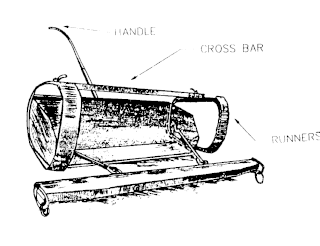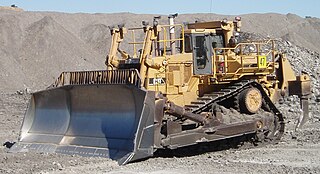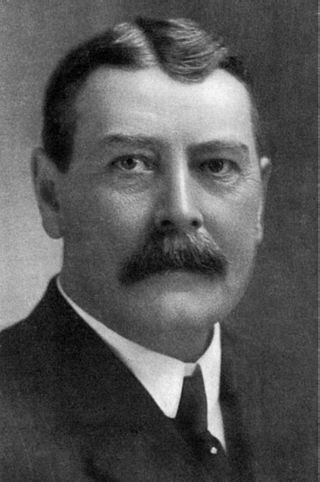
The Caterpillar D9 is a large track-type tractor designed and manufactured by Caterpillar Inc. It is usually sold as a bulldozer equipped with a detachable large blade and a rear ripper attachment.

A bulldozer or dozer is a large, motorized machine equipped with a metal blade to the front for pushing material: soil, sand, snow, rubble, or rock during construction work. It travels most commonly on continuous tracks, though specialized models riding on large off-road tires are also produced. Its most popular accessory is a ripper, a large hook-like device mounted singly or in multiples in the rear to loosen dense materials.

A lawn mower is a device utilizing one or more revolving blades to cut a grass surface to an even height. The height of the cut grass may be fixed by the design of the mower but generally is adjustable by the operator, typically by a single master lever or by a mechanism on each of the machine's wheels. The blades may be powered by manual force, with wheels mechanically connected to the cutting blades so that the blades spin when the mower is pushed forward, or the machine may have a battery-powered or plug-in electric motor. The most common self-contained power source for lawn mowers is a small internal combustion engine. Smaller mowers often lack any form of self-propulsion, requiring human power to move over a surface; "walk-behind" mowers are self-propelled, requiring a human only to walk behind and guide them. Larger lawn mowers are usually either self-propelled "walk-behind" types or, more often, are "ride-on" mowers that the operator can sit on and control. A robotic lawn mower is designed to operate either entirely on its own or less commonly by an operator on a remote control.

The Fresno Scraper is a machine pulled by horses used for constructing canals and ditches in sandy soil. The design of the Fresno Scraper forms the basis of most modern earthmoving scrapers, having the ability to scrape and move a quantity of soil, and also to discharge it at a controlled depth, thus quadrupling the volume which could be handled manually.

A loader is a heavy equipment machine used in construction to move or load materials such as soil, rock, sand, demolition debris, etc. into or onto another type of machinery.

Heavy equipment, heavy machinery, earthmovers, construction vehicles, or construction equipment, refers to heavy-duty vehicles specially designed to execute construction tasks, most frequently involving earthwork operations or other large construction tasks. Heavy equipment usually comprises five equipment systems: the implement, traction, structure, power train, and control/information.

A grader, also commonly referred to as a road grader, motor grader, or simply blade, is a form of heavy equipment with a long blade used to create a flat surface during grading. Although the earliest models were towed behind horses, and later tractors, most modern graders are self-propelled and thus technically "motor graders".

Komatsu Ltd. or Komatsu (コマツ) is a Japanese multinational corporation that manufactures construction, mining, forestry and military equipment, as well as diesel engines and industrial equipment like press machines, lasers and thermoelectric generators. Its headquarters are in Minato, Tokyo, Japan. The corporation was named after the city of Komatsu, Ishikawa Prefecture, where the company was founded in 1921. Worldwide, the Komatsu Group consists of Komatsu Ltd. and 258 other companies.

Earthworks are engineering works created through the processing of parts of the earth's surface involving quantities of soil or unformed rock.
Robert Gilmour LeTourneau, born in Richford, Vermont, was a prolific inventor of earthmoving machinery, and founder of LeTourneau Technologies, Inc and LeTourneau University. His factories supplied machinery which represented nearly 70 percent of the earthmoving equipment and engineering vehicles used by the Allied forces during World War II, and more than half of the 1,500-mile (2,414 km) Alcan Highway in Canada was built with LeTourneau equipment. Over the course of his life he secured nearly 300 patents relating to earthmoving equipment, manufacturing processes and machine tools.

The Caterpillar D11T is a large bulldozer introduced by Caterpillar Inc. in 1986 to replace its D10. Weighing 248,500 pounds (112,700 kg), it is Caterpillar's largest and most powerful bulldozer. Mainly used in the mining industry, it is also employed to push-load scrapers, and rip rock overburden. D11s are manufactured in East Peoria, Illinois.

The Caterpillar D6 track-type tractor is a medium bulldozer manufactured by Caterpillar Inc. with a nominal operating weight of 18 short tons (16 t). The military versions were classified as the SNL G152 medium tractor, under the G-numbers classification system used for army tractors.

Mighty Machines is a Canadian educational children's television series that teaches about machines and how they work. The show premiered in 1994 airing 39 episodes over three seasons until 2008.

The M9 armored combat earthmover (ACE) is a highly mobile armored tracked vehicle that provides combat engineer support to frontline forces. Fielded by the United States Marine Corps, and the United States Army, its tasks include eliminating enemy obstacles, maintenance and repair of roads and supply routes, and construction of fighting positions.

A semi-trailer is a trailer without a front axle. The combination of a semi-trailer and a tractor truck is called a semi-trailer truck.

The Euclid Company of Ohio was a manufacturer which specialized in heavy equipment for earthmoving, particularly dump trucks, loaders and wheel tractor-scrapers. It operated in the US from the 1920s to the 1950s, when it was purchased by General Motors. The firm was later bought by Hitachi Construction Machinery.

An articulated hauler, articulated dump truck (ADT), or sometimes a dump hauler, is a very large heavy-duty type of dump truck used to transport loads over rough terrain, and occasionally on public roads. The vehicle usually has all-wheel drive and consists of two basic units: the front section, generally called the tractor, and the rear section that contains the dump body, called the hauler or trailer section. Steering is made by pivoting the front in relation to the back by hydraulic rams. This way, all wheels follow the same path, making it an excellent off-road vehicle.

Joy Global Inc. was a company that manufactured and serviced heavy equipment used in the extraction and haulage of coal and minerals in both underground and surface mining. The company had manufacturing facilities in Alabama, Pennsylvania, Texas, Wisconsin, Australia, Canada, China, France, South Africa, Poland and the United Kingdom. In 2017, Joy Global was acquired by Komatsu Limited and was renamed Komatsu Mining Corp.
LeTourneau Technologies, Inc. was an American manufacturer of heavy construction equipment founded by R. G. LeTourneau. In 2011, the company was acquired by Joy Global.
The Terex THS15 Motorscraper was a concept machine scraper displayed for the first time at Minexpo 2000. This machine features some unusual design concepts, including an adjustable cutting edge on the bowl to reduce friction when loading. Other notable features were the rear-mounted drivetrain and a hydrostatic transmission, which featured hydraulic wheel motors. At least two prototypes were made, and these featured noticeable differences in front end styling. A digital copy of the brochure for this machine is available through ozebooks. Both the THS15 scrapers were spotted for sale in used machinery dealers by 2011 and their fate is unknown. Terex never went ahead with production and subsequently abandoned motor scraper manufacture altogether.


















